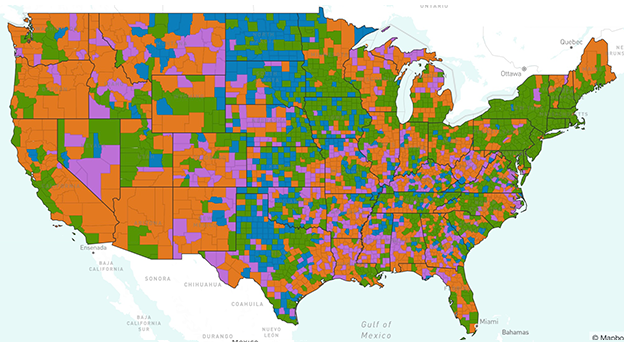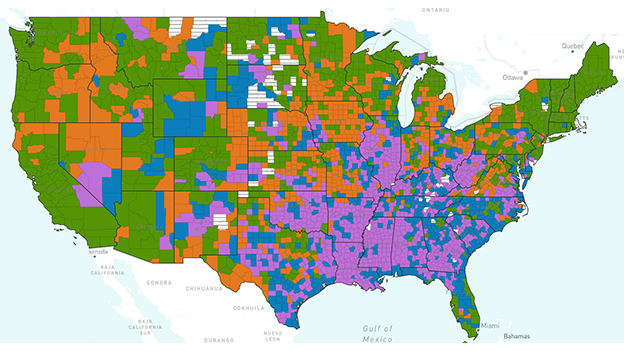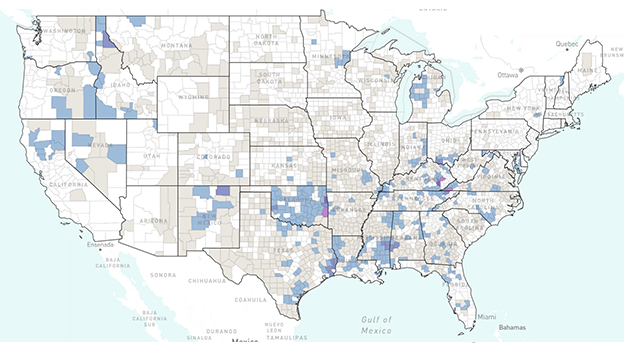The Connect2HealthFCC Task Force’s Mapping Broadband Health in America 2024 project allows users to visualize, overlay, cross-reference and analyze broadband and health data at the national, state and regional levels – allowing users to ask and answer questions about broadband and health and leverage a shared platform that can provide relevant data and contribute to the development of meaningful broadband and health policies and solutions. First launched in 2016, the platform demonstrated the value proposition of broadband in healthcare.
Version 2024 expands available high-speed connectivity data to enable more robust visualizations; introduces new indicators of maternal health, opioids, chronic diseases, and social determinants of health that underlie many of the public health crises facing the country; and reinvents the user interface and functionality.
For more details, read the Public noticevisit it FAQs, and explore it data And methodology.
Find out what the 2024 platform can do
In October 2024, the working group presented an overview of the 2024 mapping platform at the commission’s open meeting and provided a status report on the connected health landscape. The presentation included a live demo of the platform, including several use cases showing how policymakers and other stakeholders can leverage the platform to inform data-driven decision-making.
Example cards
Rural deserts of fixed broadband and maternity care
Explore the rural landscape of fixed broadband in the deserts of maternity care. According to the March of Dimesmore than 2.3 million women of childbearing age live in “maternity care deserts” – areas where there are no hospitals or birthing centers offering obstetric care and no obstetric providers – and 3 million more women live in counties with limited access to maternity care.

Internet adoption and premature birth
Learn how the digital divide in maternal health intersects with premature birth rates, revealing regional disparities that could impact maternal care.

High-speed access in high-diabetes areas
Learn how broadband access intersects with higher-than-average diabetes rates, identifying areas where landline and mobile connections can support continuous monitoring and remote care.

Opioid Abuse and Internet Adoption
Learn how the prevalence of opioid use disorder intersects with lower-than-average internet adoption, revealing target areas where broadband could support remote treatment.

Potential Benefits and Uses
Mapping Broadband Health in America maps can be used by the public and private sectors, as well as local communities, to identify opportunities and gaps in connected care.
- Maps can help tailor investments and public-private partnerships.
- Maps can be a valuable tool for highlighting areas that might need attention. They can help stakeholders identify the types of collaborations – public/private, network/applications, and outreach/education – that may be needed to improve connectivity and health.
- For the FCC and other government agencies, the maps can be used to characterize regions, patterns, and gaps to inform policies, regulatory actions, or reforms.
- For the private sector, maps can identify areas where entrepreneurial opportunities currently exist to support consumer health through broadband.
- Local communities may find the maps useful when allocating resources and focusing efforts on leveraging broadband connectivity for health.
- Over time and with periodic data updates, the maps could also be used to assess continued progress in the connected health space.
For developers
Mapping America’s Broadband Health
Provide feedback
The Working Group welcomes suggestions and feedback as it continues to improve and update the mapping platform, including additional datasets and variables for possible inclusion; other interesting features; specific use cases where the platform can inform initiatives; and other information or recommendations of interest to broadband and health stakeholders. Interested parties may submit comments and suggestions via email to engageC2H@fcc.govwith “Mapping” in the subject line; more formal comments can be submitted via the Electronic Comment Filing System in GN file no. 23-309.


